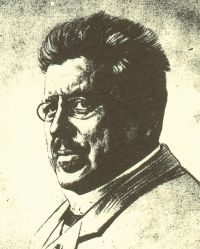

Maximilian Schwedler (1853–1940) became principal flutist of the Liepzig Gewandhaus Orchestra in 1881. He was a strong advocate of the old, conical flute. He was of course familar with the Boehm flute and understood its advantages, including its easy playing qualities. But like many German flutists, he did not believe that the 'true artist' could move the listener so strongly on anything other than a conical bore wooden flute, with its more flexible tone.
Still, Schwedler had ideas about improvements for the old flute, and perhaps realized that some changes were necessary if the instrument was to be able to hold its own, to compete with the Boehm flute. It had to become louder and more even, as all instruments had been doing in the 19th century. Certain trills in the high range needed better implementation, and some mechanical matters could stand to be improved. He had the 'modern' idea, strongly advocated by Boehm among others, of standardizing the fingering ("one note, one fingering") and of optimizing the instrument to give the best intonation, tone, and response, etc., for that fingering.
Schwedler worked with F. W. Kruspe of the Erfurt firm C. Kruspe in 1884. The next year, they introduced a new flute, the "Modell Schwedler-Kruspe 1885". Shown are below are an 11-key flute by Meyer and a flute stamped SCHWEDLER (and also Wurlitzer, on the back, in fine print) along with an illustration from Schwedler's method.



The Wurlitzer is identical to the 1885 Schwedler flute except that the former retains the long e'''/d''' trill key that was discarded by Schwedler, and it does not have an ivory head as always shown on the Schwedlerflöte.
The Modell Schwedler-Kruspe 1885 must be regarded as (still) a simple system flute. The six finger holes remain unencumbered by any mechanism; the keys on the body are still closed-standing. And the fingering is that of the simple system flutes from earlier in the century, with the exception that many of the earlier alternate fingerings were deemphasized. (Later Schwedler-Kruspe models have ring keys or other mechanism, and I would not call them simple system flutes.)
The features found on the Modell Schwedler-Kruspe 1885 that distinguish it from earlier German flutes like the Meyer flute, are summarized below.
|
We discuss these changes one by one below. Not all of the above-mentioned features are originally due to Schwedler or Kruspe, but they are all major points of difference between Schwedler's models and the Meyer-style or standard German simple system flute. The 'modern' division into sections was certainly not new, and, for example, raised cusps on either side of the embouchure can be found on some Monzani flutes from much earlier in the century. Schwedler never advocated the very large holes of English flutes or any change in fingering system, and the holes remain on the small side of medium on Schwedler flutes. (Holes were larger under the keys of the later reform flutes.)
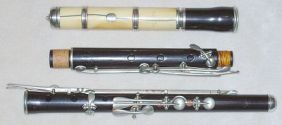 Meyerflöte |
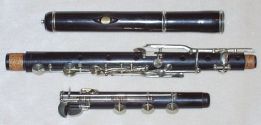 Schwedlerflöte |
(1) Construction. The new type of three piece construction was advisable because of the new A/G trill key, whose axle crosses the area between holes 3 and 4 where the usual division was made. It reduces the danger of damage always present on the old design if the key touches for LH4 and RH1 should clash when the instrument is being put together. However, the construction required that the shank of the low b key (with touch for LH4) be made in two sections and broken between the body and foot joint. So one must still be careful in putting the flute together so as to not damage the junction. The new construction also allowed for free placement of the G# key, which is mounted on a short axle with a needle spring (as it was on the Tulou flüte perfectioneé).
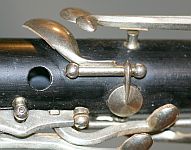
The Germans were very slow to come around to this new type of three-piece construction, and to make significant use of axles and needle springs, on simple system flutes. These features had been in use for many years on the Tulou flûte perfectioneé and English hybrid system flutes, and, of course, Boehm flutes. B. Pentenrieder's work in Munich with these ideas (and ring keys) in the 1840s was largely ignored or forgotten.
(2) Axles and foot. The foot joint keys on many 19C flutes, especially in their current conditions, are not always reliable. The construction with axles and needle springs used on modern flutes and Schwedler's flutes would appear to be more sure in its action and less likely to get out of adjustment. It facilitates some movements, say from d'# to c'# and back, that can be very awkward on some old-style foot joints. (But I personally prefer the position of the low C# key on the old-style foot when that key is often used for the sensitive fingering of c''#, namely, -23456 with the low C# key, which fingering was much used in the early and mid-19th century.)

(3) Embouchure. The Schwedler-Kruspe Modell 1885 is always depicted with an ivory head joint, but the head on the Wurlitzer 'Schwedler' shown above and below is wood. The raised cusps on either side of the embouchure were claimed by Schwedler to ease tone production and increase strength of tone. (It was not claimed that they provide any significant support for the lips.) Schwedler recommended this embouchure design for all flutes, including Boehm flutes, and it can be found on other late 19C and early 20C flutes. It is surprising that the illustration of the Modell 1885 from Schwedler's method shown above does not depict the cusps. In my opinion, any slight advantages gained from a Schwedler-Mundloch are offset by a slight decrease in flexibility; but it doesn't matter much either way—one can get used to either the Schwedler or plain embouchure.
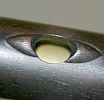

(4) Trill key #1. The Schwedler g''' trill key is shown below; the touch is the cross lever near the right of the photo. When the touch is depressed, two holes are opened: the c'' hole between finger holes 1 and 2, the same hole controlled by the side C key, and another hole a little above hole 1. When g''' is fingered as 1-3--- and these holes opened, a''' is heard. I'm not sure about what is going on accousticly, but this works well. This trill is awkward and difficult of speech and intonation without Schwedler's trill key (finger a''' as -23456 and trill with the low C# and C keys). This key could also be used for the D/C and D/C# trills in both the second and third octaves (the C key can be pressed by RH1 while RH2 operates the trill key) as well as the a'''/g'''# trill.
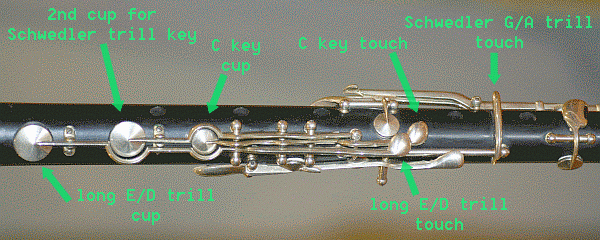
Many c.1900 flutes have a key that opens a hole just a bit above finger hole 1 that can be used for the D/C and D/C# trills, but Schwedler's key also opens the C hole between finger holes 1 and 2, and enables the a'''/g''' trill as well.
(5) Trill key #2. Schwedler replaced the second key (lever) for Bb, for RH1, with a lever in roughly the same position but which opens a second G# hole (or one in a position a bit above that, on the player's side of the flute) as well as the Bb hole. This does not much affect the use of the lever for Bb; it may still be used for the trills Bb/A and Bb/Ab, and improves the latter to some small extent. But the Schwedler lever gives the e'''/d''' trill and can also be used for the f'''/e''' trill.
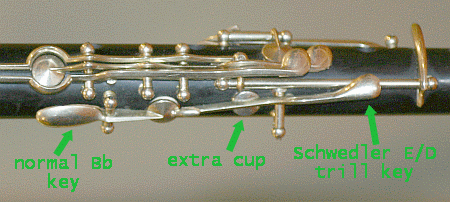
We have mentioned elsewhere the long e'''/d''' trill key introduced before 1830 and found on many German flutes, including the common 11-key type. Schwedler's e'''/d''' key works on different principles. On the whole, the trill does not speak as well and is a bit more awkward, though it is often less harsh than that given by the more common key. The d''' must almost always be played with hole 1 covered, or the e''' fails to speak. With practice, the Schwedler lever works well enough, and Schwedler dispensed with the long e'''/d''' trill key on his flutes. Yet many other makers continued to supply the standard long e'''/d''' trill key along with the Schwedler lever. This is the case on the Wurlitzer Schwedler above and on the other Schwedler flutes shown below.
(6) Bore and sound. Many flute manufacturers have claimed "improved" bores over the history of the flute. I do not know exactly how the bore was modified by Schwedler and Kruspe, but whatever the changes in bore and hole geometry and location, I do detect a significant difference in the sound made by their flutes, and instruments modeled on their ideas, compared with other late 19th century simple system flutes in the Meyer style or the Ziegler style. The Schwedler sound is full and relatively warm. The low register, while still mellow, is more penetrating. There is perhaps some loss of color and brightness in the second and third octaves compared with the best of other simple system flutes, but the tone in that range can be very attractive on its own right.
The sound of the Schwedler flute impressed Brahms, who after hearing it in the February, 1886 Leipzig premier of his fourth symphony wrote to Schwedler:
I gladly repeat in writing that I was very pleased yesterday not only about your excellent playing, but in addition about the especially full-bodied, beautiful, and powerful tone of your flute! If an invention of yours has helped you in this, then it is to be praised most warmly and to be recommended most highly. [Translation from John Bailey's thesis]
The Schwedler flute was well received. Many German players adopted it or one of its variants. Many makers borrowed one of more of its design features. The flute below has the Schwedler-Mundloch, axles on the foot keys, and the Schwedler sound, but is otherwise a simple system flute of the old construction.

The following flute (whose original head with the Schwedler-Mundloch is lost) is by the J. H. Zimmermann firm. It is very similar to the Modell Schwedler-Kruspe 1885; click here for more about the Modell Zimmermann flute.

In 1895, Schwedler and Carl Kruspe in Leipzig introduced a new model. They added to the 1885 model two new devices, both involving ring keys, in order to improve the intonation of C#/C and of F#/F. (The intonation difficulties were inherited from the one-key and simple system flutes; the interval between the standard fingerings of these notes tends to be a narrow semitone.)
The first of these was the brille with ring keys for finger holes 1 and 2 and an additional pad for a small tone hole between finger holes 1 and 2. The ring keys and cup moved together, rotating on an axle.
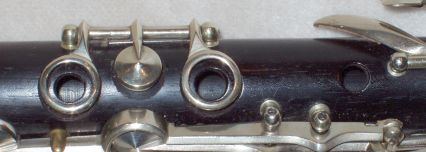
The word 'brille' is German for 'spectacles', which the device resembles. It and variations had been used on conical Boehm flutes and some English flutes earlier.
The padded cup (the 'nose' of the brille) is normally up but is pressed on its hole whenever either of finger holes 1 or 2 is closed. When c'' or c''' is fingered as -2-456k, the extra small hole is closed and the notes sounded as they would were the brille not present; similarly, if b' or b'' is fingered with 1-----, the notes worked as they would have without the brille. But if c''# was played with the left hand fingers off, it was sharpened by the additional venting of the extra small hole. The high c'''# was now playable with all holes open (which fingering normally gives a very flat c'''#).
This device Schwedler called the "Cis Brille". The other ring-key device on the Modell 1895 was the "Fis Brille"; see below. It is found on fewer flutes. The Kohlert whose brille are seen above does not have it.

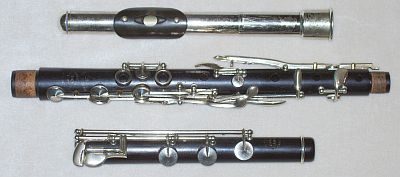
(The metal head joint of the Kohlert, with its ebonite lip plate, is of the type introduced on the Schwedler-Kruspe Reformflüte of 1898. The reform flute will be discussed in the next section. Some flutists tend to call any flute with a metal head like this a reform flute, but this is an inaccurate use of the term. The flute shown is a Schwedler flute and not a reform flute; it lacks the 'reform' from which the name arises. The metal head was used by some makers like Kohlert even on some simple system flutes with no other external Schwedler features.)
The name 'Fis Brille' is less appropriate in the sense that eyeglasses are not suggested by the appearance. This is the device shown below. Throughout the 19th century, it was recommended that an F key be opened for F# on simple system flutes, in order to keep its pitch up, though this usually made only a small difference. But with the Schwedler F# Brille, the short F key opened an extra small hole just to the left of the F hole on the player's side of the flute, more significantly raising (sharpening) the F#. It was arranged that the ring key on finger hole 5 would close this small hole, even when the short F key remained depressed, since this hole must be closed for F natural and the next few lower notes.
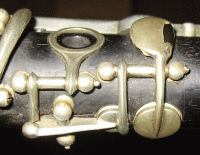
The F# Brille shown above is that of an anonymous early 20th century flute (see below) which has all of the Schwedler 1895 mechanism together with the ordinary d''' trill key and an "articulated G#" key. (The metal head joint is not shown.) Of the six finger holes, four have ring keys, but none are covered by pads. This would change on the reform flute.

Some early 20th century simple system flutes can have some of the full and penetrating Schwedler sound, even without any of the external features of Schwedler flutes. The Hammig shown on the page on German flutes is like this.
For more on Schwedler flutes, see John Bailey's thesis listed in the references.
